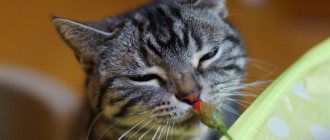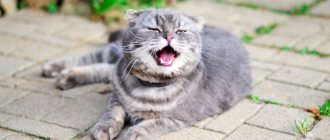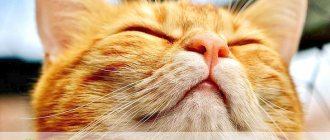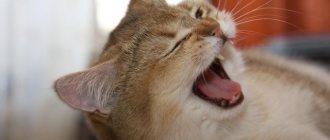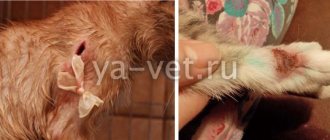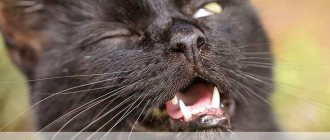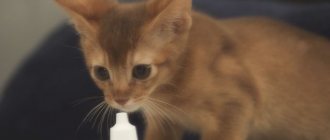The causes of sneezing in a cat can be caused by the entry into the nasal passages of various irritating particles and substances, foreign bodies, as well as bacteria, viruses and allergens that cause various diseases.
Sneezing itself is one of the unconditioned reflexes aimed at protecting the body, necessary for quickly eliminating pathological irritants from the nasal passages.
Domestic cats are capable of sneezing just like humans. A one-time sneeze should not cause concern to the owner, but a systematically repeated reflex can cause the development of serious pathological processes.
It is important to understand when sneezing is normal and when to seek help from your veterinarian for help and advice.
When is it normal for a cat to sneeze?
The reflex act of sharply inhaling deeply and exhaling forcefully through the nasal passages is called sneezing. During the process of the unconditioned reflex, various muscle groups are involved in order to carry out the strongest possible release of air from the deep parts of the lungs to cleanse the mucous membranes of unnecessary particles and irritating components. Unlike dogs, a cat can sneeze multiple times at once.
In order to clear its nasal passages, the cat actively takes a deep breath. All particles that were in the nasal passages are expelled by sneezing. Sneezing is normal and is characterized by several sets of 2-3 active sneezes. If accompanying symptoms occur, such as a runny nose, active discharge of mucous exudate from the nasal passages, lacrimation and swelling of the nose, you should consider visiting a veterinarian.
It is not too difficult to distinguish a normal condition from a pathological one. An attentive owner always notices changes in the pet’s condition in a timely manner.
A cat that sneezes from time to time and does not have parallel symptoms is absolutely healthy. The cause of sneezing can be not only dust, but also various aerosols, for example, air freshener.
The signs that appear in parallel when sneezing should alert the cat owner. Acute diseases are characterized by a specific reflex of clearing the nasal passages, loss of appetite or complete refusal to feed, lethargy and apathy. And pathological processes are accompanied by a runny nose and sudden discharge of mucous exudate.
An animal may actively sneeze when the mucous membranes are irritated by aerosols, tobacco smoke, or perfumes. At the same time, the cat does not change at all in its behavior, it is active, healthy, and does not lose its appetite. The sneezing is short, single.
Pathological causes of cat sneezing
Among the factors that provoke sneezing in a cat are a number of pathological ones. Before starting therapy, the doctor always conducts diagnostic tests to find out the cause of sneezing.
The main pathological causes of sneezing in cats are:
- Allergic type reactions. When the mucous membranes are irritated by allergens, frequent sneezing occurs. The cause of such an allergic condition can be various household chemicals, particles of which float in the air, detergents, oils and scented candles, and air fresheners.
- Colds. The cause of a cold is most often hypothermia of the body and a decrease in immune strength. In addition to sneezing, the cat has a runny nose and an increase in body temperature.
- Infectious lesions. Various fungal, bacterial and viral infections often affect the animal's respiratory tract. There is also discharge from the eyes, increased body temperature, and a severe cough.
- Helminthiases. Some types of worms can affect the respiratory tract. Settling in the respiratory organs, helminthiases are characterized by rapid breathing, runny nose, attacks of nausea and vomiting. Against the background of long-term infection with worms, the animal loses weight, and exhaustion of the body may occur. All helminthiases, in the absence of timely treatment, lead to the development of serious changes in the body, the main of which is a decrease in the body’s immune forces.
What to do
Since there are many reasons why a cat sneezes so much, which is unusual, treatment also varies. Antibiotics, antivirals, eye/ear drops, etc. are usually the primary treatment for a cat that has an upper respiratory tract infection. If your cat has a fever, your veterinarian may also prescribe antipyretics. In the meantime, you should make sure your cat eats and drinks enough.
Inflammatory conditions such as rhinitis and sinusitis require proper diagnosis. First, a professional veterinarian will perform a rhinoscopy to confirm whether your cat suffers from these diseases. However, in the meantime, broad-spectrum antibiotics and conservative treatment such as nutritional support will certainly help.
Allergic conditions, whether in humans or cats, are usually incurable. Thus, the only way to prevent exacerbation of a cat’s disease is conservative treatment.
For chronic diseases such as chronic rhinitis, there are no specific and guaranteed treatments for cats. However, you should do everything you can to relieve your cat's symptoms.
Dangerous reasons why a cat may sneeze
Pathological processes occurring in the body and characterized by sneezing can be extremely dangerous for the body. It is necessary to urgently seek help from a veterinary hospital if signs such as:
- sneezing accompanied by bloody discharge;
- nasal discharge when sneezing, characterized by the appearance of thick snot or pus;
- open-mouth breathing accompanied by sneezing;
- the presence of symptoms other than severe sneezing and nasal discharge.
The reason that the animal sneezes frequently and heavily, as well as other symptoms, may be:
- Foreign objects in the nasal passages or even in the esophagus . Most pets are extremely curious and can actively explore the world around them. Eating or inhaling small particles can cause blockage. Therefore, the reflex of clearing the nasal passages will be accompanied by heavy breathing.
- Formation of polyps in the nasal passages . The presence of benign growths or cystic neoplasms leads to constant irritation of the mucous membranes when inhaling air, so the cat may suffer from chronic runny nose and periodic sneezing.
- Development of bronchial asthma. Pets can suffer from a dangerous chronic disease, just like people. During an attack, the animal becomes lethargic, begins to sneeze, wheezing is heard and the visible mucous membranes become pale.
- Malignant tumors in the respiratory tract. Cancer of the nasal passages is rarely diagnosed in domestic cats, but it does occur. As a rule, cats with short hair and those who have reached 10 years of age are susceptible to the pathological process. Dangerous signs of nasal cancer in a cat are increased lacrimation, decreased appetite, loss of smell, and sneezing with droplets of blood.
Cold
Colds are provoked by different types of viruses, the symptoms are similar to those of humans - cough, periodic sneezing, mucous discharge from the nasal canals.
- If the cold is advanced, the cat begins to breathe through its mouth.
- The temperature rises in rare cases, but the nose noticeably dries out and becomes hot, which is why cracks often appear on it.
- The cat doesn’t like this at all, and she tries to lick her nose often in order to somehow wet it.
Colds in pets, as a rule, last no more than 4-5 days, after which the inflammatory phenomena gradually subside. A sick pet has difficulty distinguishing and perceiving odors.
First aid for a sneezing cat
In the vast majority of cases, the cause of a sneeze in a cat is a common runny nose after hypothermia, due to a cold. At home, you can alleviate your pet's condition by rinsing the nasal passages. This procedure will help cleanse the mucous passages from possible allergens. In order to cleanse the nasal passages, it is recommended:
- Take the rinsing solution and warm it to room temperature. A saline solution sold in pharmacies for newborn babies is suitable.
- Draw the solution into a syringe with the needle previously removed, and using a towel to secure the cat on its side in a lying position, pour a little liquid into one, then into the other nostril.
- It is very important to take a short break before pouring the next portion of the solution. This is necessary so that the animal has time to get rid of the remains.
- At the end of the procedure of washing the nasal passages, you can blot your nose with a dry soft napkin and release the animal.
You can independently rinse your cat’s nasal passages with saline solution at home only if you have previously consulted with a veterinarian. The fact is that sneezing can be caused by a foreign body, and rinsing leads to the pushing of foreign particles into the deep parts of the respiratory system.
The best solution would be to take the animal to a veterinary hospital. The specialist will conduct a detailed examination and prescribe a series of studies to identify the main reason that provoked the development of a specific reflex for clearing the nasal passages.
Activities in the veterinary clinic
Sneezing is not a disease. This is a specific signal from the body indicating the presence of possible irritants in the nasal passages. It is imperative to visit a veterinarian, since there may be several reasons for the development of the protective unconditioned reflex. At the clinic appointment, the doctor will conduct a general clinical examination and auscultation. It is also important to:
- general blood test - to identify a possible inflammatory process;
- blood sampling for bacterial culture - allows you to identify the bacterial infection that provoked the pathology;
- rhinoscopy – necessary to determine blockage of the nasal passages by a foreign body;
- X-rays - to identify growths, cystic growths and other changes in the nasal passages.
When sneezing is caused by mechanical damage or exposure to chemical irritants, the main goal is to eliminate the irritant itself. If an animal begins to sneeze when exposed to household chemicals, it is important to eliminate the irritating factor and conduct a thorough wet cleaning of the room where the animal lives. Some indoor plants can be a possible allergen. It is necessary to remove all plants for a while. The veterinarian prescribes medications that relieve inflammation and block the production of histamine.
If a viral infection is suspected, the doctor conducts rapid testing to determine antigens. For this purpose, PCR and ELISA tests are prescribed. A specialist who often encounters infections in domestic cats may prescribe treatment even before receiving accurate test results.
If you suspect a fungal infection or the development of pathogenic bacterial microflora, it is advisable to carry out special bacterial cultures and take smears for cytology. Only after this is it possible to develop an accurate therapeutic regimen. Most viral respiratory infections occur with complications due to the addition of bacterial microflora. In this regard, the course of treatment is based on taking antibiotics.
Lack of timely treatment leads to serious pathological processes, including infection in the lower parts of the respiratory system. The cat may develop pneumonia, bronchitis, a disorder of smell, and even loss of the ability to see normally (for example, with the development of a herpes virus infection).
Depending on the factors that provoke the development of sneezing in a cat, medications and a course of therapy are prescribed. So, with:
- allergic reactions, the cause and antihistamines are identified (if necessary, dietary nutrition is prescribed);
- viral infections - anti-inflammatory drugs, as well as antibiotics in the presence of a complicated infection;
- bacterial diseases - a course of antimicrobial drugs and immunotherapy drugs and probiotics to restore the intestinal microflora;
- fungal infections - antifungal agents (the course of therapy is usually longer than in the presence of bacterial pathogenic microflora);
- foreign bodies in the respiratory tract - surgical intervention to remove the foreign object (endoscopic removal), as well as the introduction of anti-inflammatory drugs into the cavity;
- the presence of polyps - surgical intervention to remove the tumor;
- bronchial asthma - administration of antibiotics, glucocorticoids and prescription of inhalers (in case of severe illness, the animal must be urgently placed in a special chamber with oxygen during an attack;
- malignant neoplasms in the nasal passages - rhinotomy and the introduction of serious chemicals (chemotherapy);
- helminthiases localized in the pulmonary structures - antiparasitic agents, antihistamines and vitamin complexes.
The above methods are prescribed exclusively by a qualified veterinarian, based on the results obtained during diagnostic measures. At home, it is not possible to accurately determine the cause of the development of the pathological process and subsequent sneezing in a cat.
Infection
If your pet begins to sneeze frequently, this is one of the first symptoms of inflammatory processes in the animal’s respiratory system. A cat can catch infections caused by fungi, viruses or bacteria.
With such diseases there are symptoms that appear parallel to a sneeze:
- Cough, heavy breathing with a barely noticeable whistling;
- The pet begins to discharge pus from the eyes;
- High body temperature of the animal;
- Prolonged neglect of water and food;
- Wet spots on the face, the cat rubs it on pieces of furniture and scratches it with its paws.
In this case, self-medication is unacceptable; you should contact the clinic so that a qualified veterinarian can prescribe treatment.
